Plans For Long-Term Growth At UF Health
UF Health is growing. We’re serving more patients. We’re hiring faculty and staff.
But we’re not just building programs and adding people. The landscape of our health campus is continuing to evolve, with the addition of new facilities in recent years that have helped us meet the needs across our teaching, research and patient care missions.
We’re not done yet. And since our patients are always top of mind, it makes good sense to define a strategy that will provide a state-of-the-art plan for the next 10 years of growth.
The reality is our clinical enterprise in Gainesville is now bursting at the seams. Our inpatient volume has exceeded expectations. And we have opportunities in Jacksonville to grow and better meet the needs of the larger community.
To those faculty and staff who are working at the front lines in this environment, please know that no other operational issue has higher priority than the need for new facilities. This work is being done at the level of our college and hospital administrative leadership, department chairs, the UF Health Shands Hospital Board and the UF Health Strategic Cabinet.
Earlier this week, College of Medicine dean Michael Good, UF Health Shands CEO Tim Goldfarb, and I distributed a memo to Gainesville faculty and staff regarding plans for the expansion, development and long-term growth of our Gainesville facilities. In this newsletter, I will provide greater context for planned expansion of inpatient and outpatient facilities in both Gainesville and Jacksonville, and also a recap of recent and planned facilities projects in research and education.
Inpatient Gainesville
- After thoroughly evaluating several alternatives, the UF Health Shands Hospital Board has approved funds for the design and planning of a new hospital devoted to Neuromedicine (Neurosurgery and Neurology) and to Cardiovascular Services (Cardiology, Cardiothoracic Surgery and Vascular Surgery). The design of this hospital will take place over the next several months. With this information, and after updates on the financial feasibility of this project, including philanthropic feasibility, the Board will decide on whether to proceed with construction of a hospital, containing approximately 200 beds, to the east of the Cancer Hospital on the south side of Archer Road.
- A 195-bed UF Health Shands Children’s Hospital is being constructed within the North Tower. A new cancer unit and pediatric emergency room have been completed. Underway is an ICU for the congenital heart program, which will open in the early part of 2014. A new two-story pavilion entrance and façade is about to begin construction, to be followed by a new lobby dedicated to the children’s hospital.
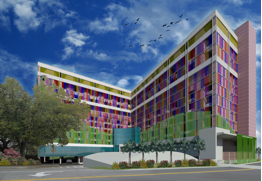
- In the next phase, a new Neonatal Intensive Care Unit will be constructed in space vacated by the Clinical Research Center (CRC) and part of the pathology laboratory. The CRC, in turn, is moving to the new Clinical and Translational Research Building, and a new home for anatomic pathology will be created in renovated space vacated by the CTSI, which is also moving to the Clinical and Translational Research Building. All of this work to create the UF Health Shands Children’s Hospital will be completed ahead of schedule.
- Similarly, extensive renovations for women’s health services are being undertaken on the north campus. The obstetrics component is closely aligned with neonatal care on the third floor. The triage center, i.e., the entry point for Labor and Delivery on the third floor, has been completely renovated. The 9th floor is now devoted to women’s health with newly renovated rooms for postpartum patients as well as post-op gynecology patients. Labor rooms and operating rooms are slated for renovation in a subsequent phase.
Inpatient Jacksonville
- We will renovate medical and surgical wards at Shands Jacksonville one at a time, as funds permit, converting semi-private to private rooms. We will begin next year with the renovation of 5 South.
- Space in the “Pavilion” hospital will be used for specialty services such as cancer, psychiatry and rehab.
- We have submitted a Certificate of Need application to build a new medical-surgical hospital at UF Health Jacksonville North, joined to the medical office building described above.
These efforts dovetail nicely with a major goal of our strategic plan, “Forward Together,” which is to align our clinical, research and education programs with our facilities. In the past, academic facility needs at the University of Florida, including the Health Science Center, were generally funded by the state using revenues generated by a tax on landline telephones ("PECO" or Public Education Capital Outlay). As the use of mobile phones has grown, PECO revenues from landlines have declined to the point where the state can fund only prior commitments. Very limited support, if any, has been provided to UF and its Health Science Center in recent years for new academic facility projects. Facility needs for the clinical enterprise have always been funded internally by our hospitals and practice plans.
The overall vision of Forward Together is to create an academic health center — now called UF Health — with unstoppable momentum. Regarding facilities, the central idea is to create an expanding virtuous circle of patient care, education and research that generates sufficient internal financial resources (from clinical revenue, philanthropy, indirect cost recovery, and royalty and other revenue streams) to fund or finance needed facility enhancements. These facility enhancements have been — and will be — either renovations of existing space or new buildings that are designed to house our evolving education, research and clinical programs.
Meanwhile, let’s recognize that, despite the absence of state funding for facilities, we have been able to accomplish a great deal since the Strategic Plan was launched. Here are highlights of some of our other key projects that have been completed in each of the key mission areas.
Outpatient Gainesville
The overall strategy is to consolidate specialty services into a few key locations, while locating primary care sites throughout the neighborhoods we serve to provide easy access.
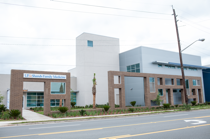 Several new primary care offices were opened and existing offices were expanded. In addition to the 10 sites for primary care already in place, on June 27, 2012 we opened UF Health Family Medicine at Main, a brand new facility located on Main Street and 16th Avenue. This serves East Gainesville and the neighborhoods surrounding UF. This project totaled 24,000 square feet and total project cost was $8 million. UF Health Family Medicine – Jonesville, which opened November 1, 2012, serves the growing communities to our west and north. Our primary care office at Magnolia Parke expanded from four physicians to five. A primary care location on the main UF campus is under consideration.
Several new primary care offices were opened and existing offices were expanded. In addition to the 10 sites for primary care already in place, on June 27, 2012 we opened UF Health Family Medicine at Main, a brand new facility located on Main Street and 16th Avenue. This serves East Gainesville and the neighborhoods surrounding UF. This project totaled 24,000 square feet and total project cost was $8 million. UF Health Family Medicine – Jonesville, which opened November 1, 2012, serves the growing communities to our west and north. Our primary care office at Magnolia Parke expanded from four physicians to five. A primary care location on the main UF campus is under consideration.
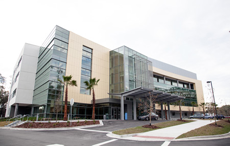 Specialty services that were in dispersed locations (in leased space) have been consolidated at a new multispecialty medical office building on 39th Avenue near Interstate 75 (UF Health Springhill). This includes cardiology, dermatology, women’s services (including IVF and imaging), pain medicine, neurology and psychiatry. This project, which opened December 13, 2012, totaled 112,000 square feet and cost $35 million.
Specialty services that were in dispersed locations (in leased space) have been consolidated at a new multispecialty medical office building on 39th Avenue near Interstate 75 (UF Health Springhill). This includes cardiology, dermatology, women’s services (including IVF and imaging), pain medicine, neurology and psychiatry. This project, which opened December 13, 2012, totaled 112,000 square feet and cost $35 million.
Outpatient Jacksonville
- On August 14, we broke ground on a new ambulatory facility on our 70-acre North Jacksonville property, located near the airport across from the River City Mall. This will be anchored by a freestanding emergency room, imaging center and surgi-center, and include four floors of medical office space for faculty and community physicians.
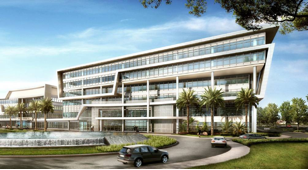
- Primary care locations are being consolidated into designated medical homes.
- A “Total Care Clinic” has been created in renovated VA clinic space on the 8th Street campus to provide managed care to “City Contract” patients.
- The 8th Street outpatient facilities are being improved, including a much enhanced registration/lab/radiology area, and renovation of existing offices.
Veterinary facilities
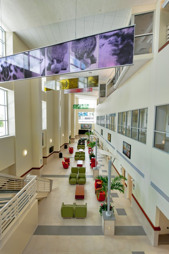 Small Animal Hospital - The college's $58 million, 100,000-square foot facility is home to a wide range of veterinary specialty services, all staffed by board-certified specialists, residents and interns, and supported by certified veterinary technicians. Sophisticated diagnostic imaging capabilities, modern surgical suites, an intensive care unit and a spectrum of cutting edge technologies assist clinicians in the diagnosis and treatment of difficult and complex diseases. The hospital offers well-pet care and dentistry to small animal patients and Wellness Plans provide discounted preventive veterinary services. This award-winning building is the first veterinary facility in the country to achieve Gold Leadership in Energy and Environmental Design, or LEED, certification.
Small Animal Hospital - The college's $58 million, 100,000-square foot facility is home to a wide range of veterinary specialty services, all staffed by board-certified specialists, residents and interns, and supported by certified veterinary technicians. Sophisticated diagnostic imaging capabilities, modern surgical suites, an intensive care unit and a spectrum of cutting edge technologies assist clinicians in the diagnosis and treatment of difficult and complex diseases. The hospital offers well-pet care and dentistry to small animal patients and Wellness Plans provide discounted preventive veterinary services. This award-winning building is the first veterinary facility in the country to achieve Gold Leadership in Energy and Environmental Design, or LEED, certification.- Ocala ER - The UF Pet Emergency Treatment Services clinic is a 5,000-square foot after-hours facility located in Ocala. Recently celebrating its one-year anniversary, the clinic provides basic to advanced emergency care between 5 p.m. and 8 a.m. during the week and is open around the clock on weekends and holidays. UF small animal emergency and critical care clinicians staff the clinic, with the help of additional support personnel. The staff rotates shifts in Ocala while continuing to provide services at the UF Small Animal Hospital in Gainesville.
Research
Gainesville
- The Emerging Pathogens Institute and Biomedical Science Building opened in 2010-2011. The laboratory space in these state-of-the-art facilities was assigned to new investigators recruited to UF, and to existing investigators with expanding research programs.
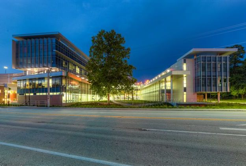 Faculty and staff have been moving into the new Clinical and Translational Research Building (CTRB) over the past several weeks. The official opening of the CTRB was earlier this month. This unique facility accommodates faculty and staff in several complementary and intertwined research units: Institute on Aging, Clinical and Translational Science Institute (CTSI), Clinical Research Center, the departments of Epidemiology, Biostatistics and Health Outcomes and Policy, and selected clinical research programs, including muscular dystrophy, diabetes, rare and genetic diseases, metabolomics, personalized medicine, hepatobiliary diseases and pain research.
Faculty and staff have been moving into the new Clinical and Translational Research Building (CTRB) over the past several weeks. The official opening of the CTRB was earlier this month. This unique facility accommodates faculty and staff in several complementary and intertwined research units: Institute on Aging, Clinical and Translational Science Institute (CTSI), Clinical Research Center, the departments of Epidemiology, Biostatistics and Health Outcomes and Policy, and selected clinical research programs, including muscular dystrophy, diabetes, rare and genetic diseases, metabolomics, personalized medicine, hepatobiliary diseases and pain research.- With a large number of faculty and staff moving into the CTRB, optimizing the use of vacated space is critical. The assignment of investigators to vacated research space is been accomplished based on scientific alignment and external funding benchmarks.
Jacksonville
- In Jacksonville, we have focused on clinical and community-based research rather than lab research.
- With sufficient growth in research volume, the potential for a research building adjacent to the UF Proton Therapy Institute on the 8th Street campus is being explored. Funding for this building will depend in large part on sufficient interest among potential donors and/or the state Legislature.
Lake Nona
- The UF Research and Academic Center at Lake Nona opened Nov. 30, 2012. This $53 million, 106,000-square-foot facility is a bold introduction of UF’s research presence into the greater Orlando area.
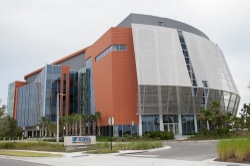
- There are four floors of research space at the Lake Nona facility. The fourth floor is for the Center for Pharmacometrics and Systems Pharmacology (College of Pharmacy), which focused on mathematical modeling and computer simulation of clinical trials to speed the discovery and approval of safe, effective and affordable new drugs.
- The third and second floors are for the Institute for Therapeutic Innovation (College of Medicine), which focuses on developing and testing new treatments and cures for a variety of infectious diseases caused by drug-resistant pathogens.
- The first floor is space for clinical trials to be conducted by the Institute on Aging and the CTSI
Education
- Over the past two years, there have been major upgrades to main education facility at the Health Science Center — the “Communicore.” The lecture halls, entry lobby and library have been substantially upgraded, both in form and function. Some work remains on the upper floors, and this is either in progress or being planned.
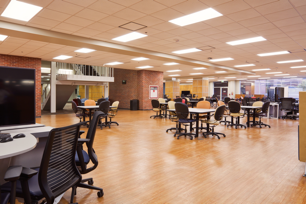
- Last year, the College of Veterinary Medicine built a state-of-the-art 160-seat auditorium. Although mainly intended for CVM students, this auditorium can be used for conferences and other functions. The ability to videoconference in high-definition with operating rooms and lecture halls at UF and around the world is one of the key features of the new space. The auditorium is equipped with three high-definition cameras, high-definition projectors, a sound system with flat panels embedded in the ceiling to capture not only what the lecturer says but also what students say and an expanse of white-screen wall large enough for three projections to appear at once.
- The new research building described above in Lake Nona also contains education space for the College of Pharmacy Pharm.D. program in Orlando. This new facility will allow for the expansion of the UF Pharm.D. program to expand from 200 students to 280 over four years.
- The renovation of the medical student dorm in Jacksonville has been completed and is now in use.
- Last year, under the leadership of then dean Terri Dolan, D.D.S., College of Dentistry faculty participated in a planning process for a new dental building for education, clinical practice and clinical research. It is anticipated that this facility would extend east from the existing dentistry building. Funding for this project is now being pursued.
- Beginning three years ago, the idea for a new Medical Education Building began to take shape. It was important for the faculty first to design a new medical education curriculum, so that the new building could be designed around the educational program it would house. The process of developing the new curriculum was facilitated by Joe Fantone, M.D., senior associate dean for medical education. Once the curriculum was set, with its emphasis on small group learning, simulation, interdisciplinary teams, and a new focus on primary care, a preliminary architectural design was established. With these education and design plans in hand, Dean Mike Good, M.D., and the development team were able to raise in cash and pledges more than half of the estimated $46 million cost. Detailed architectural plans and construction documents are just about completed on what will truly be a national model for medical education facilities. We will break ground on this building in November.
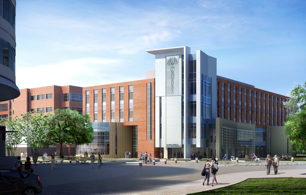 In our May 20, 2010 Strategic Plan, we began with the fundamental principle of alignment between health science center faculty and hospital administration. Our vision statement then stated: “Together we strive to create unstoppable momentum toward the goal of improving individual and community health through discovery, clinical and translational science and technology, exceptional education, and patient-centered, innovative, high-quality health care.”
In our May 20, 2010 Strategic Plan, we began with the fundamental principle of alignment between health science center faculty and hospital administration. Our vision statement then stated: “Together we strive to create unstoppable momentum toward the goal of improving individual and community health through discovery, clinical and translational science and technology, exceptional education, and patient-centered, innovative, high-quality health care.”
This was the ampersand. This is now UF Health. It feels like we’re becoming unstoppable. There’s not a more talented and devoted group of faculty and staff anywhere to make this vision come alive. I am humbled and privileged to work on this effort with you.
Forward Together,
David S. Guzick, M.D., Ph.D. Senior Vice President, Health Affairs President, UF Health
- Department of Biostatistics
- Department of Community Health and Family Medicine
- Department of Epidemiology
- Department of Health Outcomes & Biomedical Informatics
- Clinical and Translational Science Institute
- College of Dentistry
- College of Medicine
- College of Pharmacy
- College of Public Health and Health Professions
- College of Veterinary Medicine
- Emerging Pathogens Institute
- Institute on Aging
- UF Health Jacksonville
- UF Health Shands Children's Hospital
- University of Florida Health Science Center
- UF Health
- University of Florida
About the author
